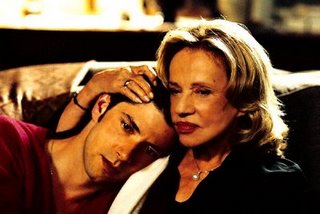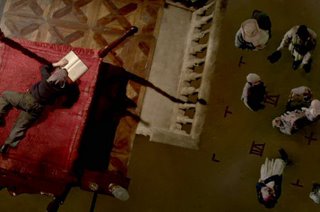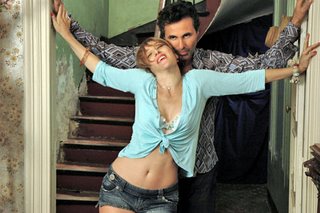Strange fruit
 Ever imagine a sex scene between classic British actress Helen Mirren and Cuba Gooding Jr? How about a romantic coupling between Mysterious Skin's Joseph Gordon-Levitt with Phat Girlz' Mo'Nique? If you answered yes to either of these questions, then perhaps you could comprehend the perplexing logic which functions in producer Lee Daniel's directorial debut, Shadowboxer. Riding on the shock-value, yet critically successful coat-tails of Daniel's co-produced grimfests Monster's Ball and The Woodsman (you can find my review of the latter here), Shadowboxer strives to achieve a similar level of disquieting gloom. But here, random would seem to be the over-riding goal. Just from the opening credits, a laundry list of notable names causes one to snicker because of their seemingly arbitrary assembly. Helen Mirren, Cuba Gooding Jr., Macy Gray, Mo'Nique, Joseph Gordon-Levitt, Stephen Dorff... Costumes by Vivienne Westwood!I've joked already that the whole thing sounding like a game of casting Yatzee - and I haven't even gotten to the plot yet.
Ever imagine a sex scene between classic British actress Helen Mirren and Cuba Gooding Jr? How about a romantic coupling between Mysterious Skin's Joseph Gordon-Levitt with Phat Girlz' Mo'Nique? If you answered yes to either of these questions, then perhaps you could comprehend the perplexing logic which functions in producer Lee Daniel's directorial debut, Shadowboxer. Riding on the shock-value, yet critically successful coat-tails of Daniel's co-produced grimfests Monster's Ball and The Woodsman (you can find my review of the latter here), Shadowboxer strives to achieve a similar level of disquieting gloom. But here, random would seem to be the over-riding goal. Just from the opening credits, a laundry list of notable names causes one to snicker because of their seemingly arbitrary assembly. Helen Mirren, Cuba Gooding Jr., Macy Gray, Mo'Nique, Joseph Gordon-Levitt, Stephen Dorff... Costumes by Vivienne Westwood!I've joked already that the whole thing sounding like a game of casting Yatzee - and I haven't even gotten to the plot yet.
 Helen Mirren and Cube Gooding Jr. are a duo of assassins. While on assignment, they discover that the woman whom they are supposed to be snuffing is not only 9 months pregnant but inducing labor at that very moment. Mirren, who is slowly dying of cancer, has one of those trite "life - death" moments and believes that God has put her in this moment for a purpose. So, instead of shooting her in the head, she delivers the child and takes the two into hiding. Enter Gordon-Levitt and Mo'Nique (playing a character named Precious) as a doctor and nurse team(yes, you are reading correctly). Of course, Stephen Dorff(who has a gruesomely gratuitous be-condom'd full frontal fuck shot) is the mother's husband and has a nack for nasty murders. Convinced that she is dead, her moves on to her best friend (a debilitatingly drunk Macy Gray). That's the first half, at least. Then, as you may have surmised, the film becomes an idyllic, watching baby grow in a secluded country house movie.
Helen Mirren and Cube Gooding Jr. are a duo of assassins. While on assignment, they discover that the woman whom they are supposed to be snuffing is not only 9 months pregnant but inducing labor at that very moment. Mirren, who is slowly dying of cancer, has one of those trite "life - death" moments and believes that God has put her in this moment for a purpose. So, instead of shooting her in the head, she delivers the child and takes the two into hiding. Enter Gordon-Levitt and Mo'Nique (playing a character named Precious) as a doctor and nurse team(yes, you are reading correctly). Of course, Stephen Dorff(who has a gruesomely gratuitous be-condom'd full frontal fuck shot) is the mother's husband and has a nack for nasty murders. Convinced that she is dead, her moves on to her best friend (a debilitatingly drunk Macy Gray). That's the first half, at least. Then, as you may have surmised, the film becomes an idyllic, watching baby grow in a secluded country house movie.
Not a single moment of traditional logic plays itself out in Shadowboxer. Neither does the film create a world in which its bizarre moments make sense. In one scene, a drunk Macy Gray asks the bereft and haggard tranny sitting next to her in an otherwise upscale bar if she wants a drink. 'What is this to' up tranny doing here?' one might wonder. A dramatic draft causes Mirren's kimono to billow in one of the few scenes where we see the pain caused by her cancer (I've never seen a healthier terminal cancer patient - nor one who smoked more cigarettes). Trouble is, she's indoors. 'Where, pray tell, is this interior gale?' Every black character has a substance abuse problem, save Gooding Jr. who is, instead, a masochist. Everyone seems to light their cigarettes whenever the new-born is brought into the room. Rats race Mo'Nique in Gordon-Levitt's doctor's office. You get the idea.
 Now, because of all of this absurdity, Shadowboxer is actually a bit of a pleasure to behold. Oh, it's bad alright, and it looses precious steam when Mirren parts ways with the cast, but as a bizarre amalgam of Lifetime Women's movie and TNT style thriller it's rather priceless. The poor decision to theatrically distribute the film will not prove economically fruitful. This is one of those films which may (and I stress may) develop some sort of cult appreciation on DVD. As an almost self-fulfilling act, one scene finds a character watching Susan Hayward and her mobile co-star belt out "I'll plant my own tree" from Valley of the Dolls. The odd mish mash casting proves more desperate here than awkward as it was in Monster's Ball and The Woodsmen. Obviously someone has a bunch of industry ins, but I'm not sure that means they should necessarily use them. Save this one for the last in a alcohol addled marathon evening, but do see it. It's perplexingly sensational.
Now, because of all of this absurdity, Shadowboxer is actually a bit of a pleasure to behold. Oh, it's bad alright, and it looses precious steam when Mirren parts ways with the cast, but as a bizarre amalgam of Lifetime Women's movie and TNT style thriller it's rather priceless. The poor decision to theatrically distribute the film will not prove economically fruitful. This is one of those films which may (and I stress may) develop some sort of cult appreciation on DVD. As an almost self-fulfilling act, one scene finds a character watching Susan Hayward and her mobile co-star belt out "I'll plant my own tree" from Valley of the Dolls. The odd mish mash casting proves more desperate here than awkward as it was in Monster's Ball and The Woodsmen. Obviously someone has a bunch of industry ins, but I'm not sure that means they should necessarily use them. Save this one for the last in a alcohol addled marathon evening, but do see it. It's perplexingly sensational.


















